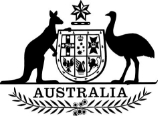
Telecommunications (Interception and Access) Amendment (2021 Measures No. 1) Regulations 2021
I, General the Honourable David Hurley AC DSC (Retd), Governor‑General of the Commonwealth of Australia, acting with the advice of the Federal Executive Council, make the following regulations.
Dated 25 November 2021
David Hurley
Governor‑General
By His Excellency’s Command
Karen Andrews
Minister for Home Affairs
1 Name
This instrument is the Telecommunications (Interception and Access) Amendment (2021 Measures No. 1) Regulations 2021.
2 Commencement
(1) Each provision of this instrument specified in column 1 of the table commences, or is taken to have commenced, in accordance with column 2 of the table. Any other statement in column 2 has effect according to its terms.
Commencement information |
Column 1 | Column 2 | Column 3 |
Provisions | Commencement | Date/Details |
1. The whole of this instrument | The day after this instrument is registered. | 30 November 2021 |
Note: This table relates only to the provisions of this instrument as originally made. It will not be amended to deal with any later amendments of this instrument.
(2) Any information in column 3 of the table is not part of this instrument. Information may be inserted in this column, or information in it may be edited, in any published version of this instrument.
3 Authority
This instrument is made under the Telecommunications (Interception and Access) Act 1979.
4 Schedules
Each instrument that is specified in a Schedule to this instrument is amended or repealed as set out in the applicable items in the Schedule concerned, and any other item in a Schedule to this instrument has effect according to its terms.
Schedule 1—Amendments
Telecommunications (Interception and Access) Regulations 2017
1 At the end of Part 2
Add:
10A Identifying and blocking malicious SMS messages
(1) For the purposes of subsection 7(2A) of the Act, the matters in subsection (3) of this section are specified for the purposes of determining whether an act or thing done by a person for the purposes of identifying and blocking malicious SMS messages was reasonably necessary in order for the person to perform the person’s duties mentioned in paragraph 7(2)(a) of the Act effectively.
(2) For the purposes of subsection 108(4) of the Act, the matters in subsection (3) of this section are specified for the purposes of determining whether an act or thing done by a person for the purposes of identifying and blocking malicious SMS messages was reasonably necessary in order for the person to perform the person’s duties mentioned in paragraph 108(2)(d) of the Act effectively.
Matters to which court is to have regard
(3) For the purposes of subsections (1) and (2), the matters are the following:
(a) the impacts of malicious SMS messages, and actions taken by users of telecommunications systems in response to those messages, on the operation and maintenance of telecommunications systems;
(b) the extent to which the act or thing assists in identifying and blocking malicious SMS messages;
(c) community expectations that malicious SMS messages should be identified and blocked;
(d) the financial or psychological harm caused, or likely to be caused, by malicious SMS messages;
(e) the extent to which the act or thing is done in a way that minimises any impacts on users of telecommunications systems, including any impacts on the privacy of users.
(4) To avoid doubt, nothing in this section limits the matters that a court may have regard to.
Malicious SMS messages
(5) For the purposes of this section, an SMS message is a message communicated by means of a short message service or a multimedia message service.
(6) For the purposes of this section, an SMS message is a malicious SMS message if:
(a) the SMS message contains a link or a telephone number; and
(b) the purpose, or apparent purpose, of the SMS message is to mislead or deceive a recipient of the SMS message into using the link or telephone number; and
(c) the recipient would be likely to suffer detriment as a result of using the link or telephone number.
